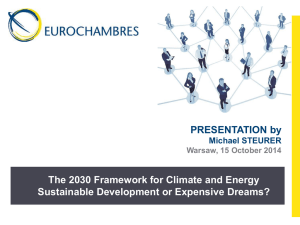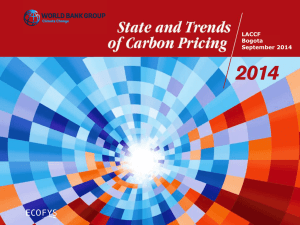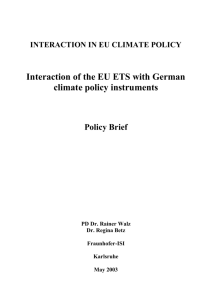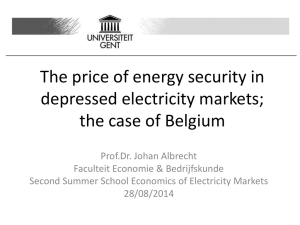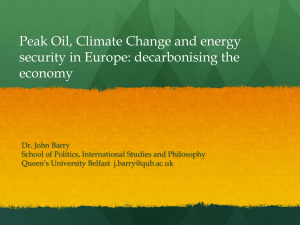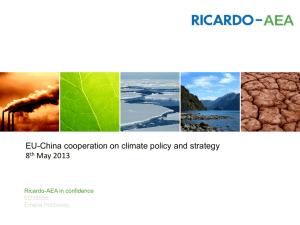The road to a 2030 framework
advertisement
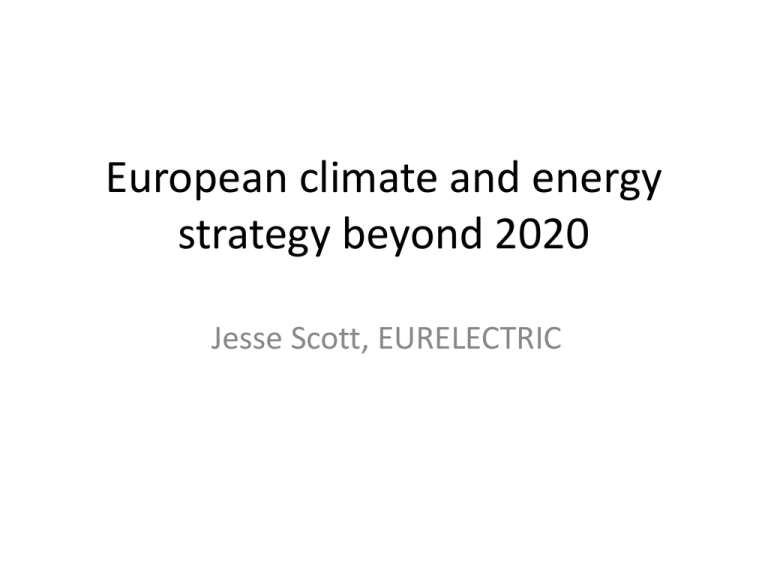
European climate and energy strategy beyond 2020 Jesse Scott, EURELECTRIC The big picture – decoupling growth from emissions …all call for strong, stable carbon pricing What’s driving price rises? ETS as the key driver Strong innovation policy MARKETS ARE FRAGMENTED AND POLICIES ARE START/STOP ENERGY MARKET INTEGRATION AND (MORE) PREDICTABLE POLICIES Today: internal energy market or x28 chaos? UK carbon price floor NL coal tax National RES and EE schemes National carbon price floors/taxes National capacity mechanisms Alternatives for the 2030 package ETS IED AQ ETS EPS (IED, AQ) RES innov. support RES support EE regl. demand -side EE regl. supply-side and demand-side The road to a 2030 framework Step 1: 22 Jan 2014: Commission proposals on goals Step 2: October 2014: European Council political decision on goals Step 3: 2015: Commission drafts legislation to implement goals, spread burdens (Publication before/after Paris COP21?) Step 4: 2016-17: Parliament and Council Co-Decision on legislation Step 5: 2018-19: National transposition where necessary The road to a 2030 framework Step 1: 22 Jan 2014: Commission proposals on goals Step 2: October 2014: European Council political decision on goals September 2014-Q1 2015: ETS MSR Co-Decision Step 3: 2015: Commission drafts legislation to implement goals, spread burdens (Publication before/after Paris COP21?) Step 4: 2016-17: Parliament and Council Co-Decision on legislation Step 5: 2018-19: National transposition where necessary The road to a 2030 framework Step 1: 22 Jan 2014: Commission proposals on goals …includes carbon leakage list 2015-20 Step 2: October 2014: European Council political decision on goals September 2014-Q1 2015: ETS MSR Co-Decision Step 3: 2015: Commission drafts legislation to implement goals, spread burdens (Publication before/after Paris COP21?) ...includes new ETS linear factor …includes carbon leakage list 2021-30 Step 4: 2016-17: Parliament and Council Co-Decision on legislation Step 5: 2018-19: National transposition where necessary ETS is preferable versus other emissions policies Carbon tax (x28 national, not EU) Cap-and-trade market = ETS Emissions limit values (portfolio/plant) The ETS does three jobs in one… Global linking (potential) Emissions reduction Revenues (for lowcarbon investment) Global success of the ETS What’s wrong with the ETS today…? Alternative policies? Investment signal? ETS problems and reforms 3 different problems, 3 different solutions Short-term: Surplus of 2.6bn EUAs by 2020 Solution: permanent set-aside Medium-term: Fixed supply and demand shocks result in price volatility Solution: market stability mechanism Long-term: The ETS cap is not coherent with the EU 2050 goal Solution: strengthen the linear factor ETS reforms Step by step through 5 policy processes (so far) Process Impact Status In force Goals 1. Back-loading Cosmetic fix, helps market confidence Done 2014-18 // 2. Market stability reserve Useful re price volatility, slow impact on surplus In Co-Decision 2021? From 2017, include backload 3. Set-aside Could solve surplus, no impact on linear factor Political debate n/a Member State consensus? 4. Linear factor revision Crucial, but only slow impact on surplus White paper 2021? Stronger %? 5. Extension to more sectors Would help secure the ETS system, could solve surplus and linear factor Under consideration After 2021 COM White Paper € carbon price Getting to the goal on ETS When can we get real changes? Take-off? Threshold carbon price which can impact opex + capex 2014 2015 2016 2017 2018 2019 2020 2021 Competitiveness, energy and climate What’s at issue? • There is no such thing as a global level playing field on energy – Europe and the US have different energy situations, so need different energy strategies • Competitiveness is a whole-economy issue – Policies favouring/exempting one sector may have a negative impact on other sectors • Intra-European tax/price/policy differentials result in intra-European leakage – Dutch and German steel compete in the same market but under different renewables, carbon and power prices Four possible outcomes re the RES target 1: EU RES target delivered through national targets and support schemes Market fragmented and distorted 2: EU RES target with EU harmonisation of support schemes (not yet clear how this would work) Market distorted but not fragmented 3: EU RES target delivered through ETS (mature RES) and innovation support (immature RES) Fully market compatible 4: No EU RES target Unlikely in light of Commission, German, and European Parliament opposition…. The RES increase challenge 21% of electricity mix today to 45% by 2030 EU RES 2013 – approx 21% 5% biomass 10% hydro 5% biomass 10% hydro 6% intermittent EU RES 2030 – approx 45% a x5 increase in intermittent generation ? 30% intermittent

